How You Could Save £226,436 Just By Maxing Out Your ISAs
Do you have taxable investments or savings? This article should be of interest if you pay income tax, but particularly if you pay income tax at 40% or greater, or if you own a business and pay yourself via dividends. We explain how to use your ISA allowance to dramatically cut your tax bills.
Our case study shows how one couple could reduce the total tax paid on their investments by an incredible £226,436 over 20 years. This brings the effective tax rate of the account down from 21% to less than 1%. All this just by using their ISA allowances every year!
Each tax year you get an ISA allowance, which you can use to shelter your savings or investments completely from tax. Most people underestimate the incredible power of ISAs, and the result is that you could be paying much more tax than you realise. This article examines the actual tax savings of using ISAs, and gives real-life data to show the way to maximise your tax savings using your ISA allowance. Read more about investing with ISAs.
Key points:
How your ISA allowance works
Each adult gets an ISA allowance to use each tax year. Currently, the ISA allowance is £20,000 per person. Your ISA allowance allows you to shelter your savings or investments completely from income tax and capital gains tax. Think of your ISA allowance as a wrapper around any existing account. This can be applied to cash or lots of investment types.
Why is the ISA allowance so powerful?
Most people think about using ISAs to shelter their bank savings from interest by using a cash ISA. While this is sensible, it does not maximise your tax savings. If you use your ISA allowance to shelter invested assets (using a stocks and shares ISA), the potential growth should be much greater over time, and therefore the potential tax savings should be much larger too. The ISA allowance helps you to avoid certain taxes completely. You can also access your money at any stage without fear of having to pay tax, unlike taxable investments or pensions. One of the most powerful elements of your ISA is that you can use it for tax-free income.
Taxes the ISA allowance helps you to avoid
Your ISA allowance allows you to completely avoid the following taxes:
Income tax
Interest
You pay income tax on interest accumulated in bank accounts or investments like corporate bonds and gilts. Your earned income is taxed first, and your other income added in last. Therefore, income tax on your savings or investments may be charged at 20%, 40% or 45% depending on income from other sources. You get certain allowances before you pay income tax on interest – £1,000 per tax year if your interest falls in the basic rate income tax band, or £500 if you pay income tax at the higher rate.
Dividends
You pay income tax on dividends received on shares. You pay income tax at 8.75% on income within the basic rate band, and at 33.75% if you are a higher rate tax-payer. You also get an annual allowance for dividends so you do not pay tax on the first £2,000 received. This can be an issue for you if you own a business an pay yourself via dividends. While the income from your business will be taxed at a lower rate, this can mean that you pay additional tax on your investments. Read more about taxation of investments.
Why should you care about income tax?
You should be concerned about income tax if you have other sources of income. This is particularly true if you pay income tax at 40% or 45%. The income tax on your investments will need to be paid regardless of whether you draw an income. This tax effectively reduces the growth rate of your investments. The impact of income tax typically only gets worse as your investments grow in value. Imagine your investment generates interest at 10% of £10,000 per year. If this is taxed at 20%, you would have to pay £2,000 in income tax, reducing the interest from 10% to 8%. If the interest is taxed at 40%, you would have to pay income tax of £4,000, reducing the interest from 10% to 6%. This income held in an ISA would not pay any tax. Over time the tax paid really adds up.
Capital gains tax
When you sell your investments, you pay capital gains tax on the growth in the value of your investments. The capital growth is calculated by taking the final value and deducting the original value, plus any other costs and charges. You are allowed to make capital gains of £12,300 per person in any tax year. After that, the gain is added to your income for the tax year. Any gains falling in the basic rate income tax band are taxed at 10%; all other gains are taxed at 20%. Property capital gains are taxed at 18% or 28%.
Why should you care about capital gains tax?
Imagine you sell your investments after 10 years. The capital growth on those investments could be significant. The tax to pay on sale might be many thousands of pounds, and would effectively reduce the overall growth. This tax bill typically only gets bigger the longer you hold your investments. Imagine you invested £100,000 and this grew over time to be worth £200,000. If you sold that investment you would have made a capital gain of £100,000. Your capital gains tax on this investment gain might be between £8,770 to £17,540. Read more about capital gains tax on investments.
Our ISA allowance research
We built a model to compare the probable tax due on an investment account, based on certain investment assumptions. This model examines the following scenarios:
- Single taxable account without using ISAs This scenario assumes you set up a single taxable investment account.
- Joint taxable accounts This scenario assumes you set up a joint taxable investment account. This approach should be better than a single taxable account because you will use 2 allowances for tax. If one partner is a higher rate tax payer, you may pay more income tax.
- Single taxable account also using ISAs This scenario assumes you set up a single taxable investment account, but gradually move money into ISAs each tax year.
- Joint taxable accounts also using ISAs In theory this should be the most tax-efficient option, since you get to use the tax allowances of 2 partners, and ISA allowances for 2 people.
Case study – Jerry and Margo
Jerry is a senior manager at a plastics company, and is therefore an employee paying 40% income tax. Margo works part-time and pays 20% income tax. We have assumed they have £300,000 to invest.
Income tax
This chart shows the cumulative income tax paid on interest and dividends in the account over time.
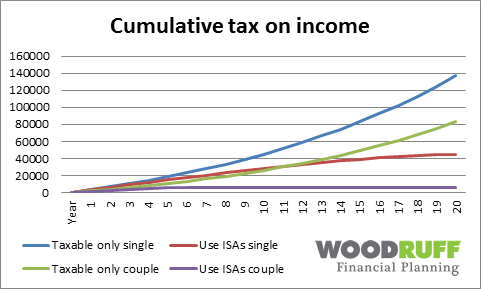
- Single taxable account without using ISAs (blue line) If Jerry invests in a taxable account in his own name only, after 20 years we calculate he would have paid £136,933 in income tax. This would have been reduced to £49,457 had they instead invested in Margo’s name only.
- Joint taxable accounts (green line) If the couple sets up a joint taxable account they will pay £83,034 in income tax over 20 years. By splitting ownership between Jerry and Margo, they save £53,899 in income tax.
- Single taxable account also using ISAs (red line) By using Jerry’s ISA allowance, he can reduce the income tax paid over 20 years to £44,600. Just by using Jerry’s ISA allowances, he can save a massive £92,333 in income tax!
- Joint taxable accounts also using ISAs (purple line) If the couple sets up a joint taxable investment account, and uses both ISA allowances, the income tax paid over 20 years reduces to £6,293. In fact the income tax stops after 8 years. This is a massive saving of £130,640 just by using sensible planning.
Capital gains tax
This chart shows the cumulative capital gains tax on a full withdrawal from the investment.
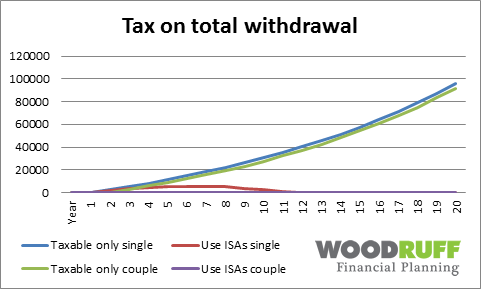
- Single taxable account without using ISAs (blue line) If Jerry invests in a taxable account in his own name only, after 20 years we calculate he would pay £95,795 in capital gains tax if he makes a full withdrawal from his account. If the same investment had been made in Margo’s name, the capital gains tax would be the same.
- Joint taxable accounts (green line) If the couple sets up a joint taxable account they each get to use an annual allowance for capital gains tax. This reduces the tax payable after 20 years to £91,902, a saving of £3,893.
- Single taxable account also using ISAs (red line) By using Jerry’s ISA allowance, he can reduce the capital gains tax paid after 20 years to £0. Just by using Jerry’s ISA allowances, he can save a massive £95,795 in capital gains tax! The account should be free of capital gains tax after 12 years.
- Joint taxable accounts also using ISAs (purple line) If the couple sets up a joint taxable investment account, and uses both ISA allowances, the capital gains tax paid after 20 years reduces to £0. In fact the accounts should never attract capital gains tax. Again, this is a massive saving of £95,795 just by using sensible planning.
Tax as a percentage of the final value
This chart examines the combined effect of the tax payable over time.
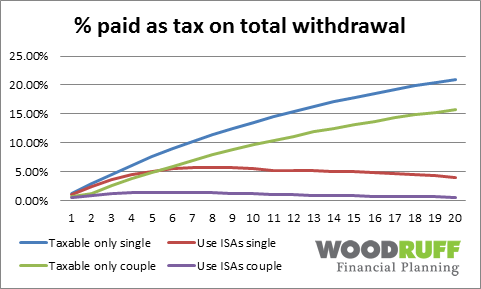
- Single taxable account without using ISAs (blue line) If Jerry invests in a taxable account in his own name only, after 20 years we calculate he would pay 21.0% in tax. If the same investment had been made in Margo’s name, the total tax would represent 13.1% of the total value.
- Joint taxable accounts (green line) If the couple sets up a joint taxable account, the total tax after 20 years would be 15.8% of the total value.
- Single taxable account also using ISAs (red line) By using Jerry’s ISA allowance, the total tax would be 4.0% after 20 years.
- Joint taxable accounts also using ISAs (purple line) If the couple sets up a joint taxable investment account, and uses both ISA allowances, the total tax would have been 0.6% of the total value after 20 years. Sensible planning reduces the effective tax rate by over 20% of the final capital value!
Total tax saved by using ISA allowances
This chart shows the value of the tax saved using each option compared to the single taxable account.
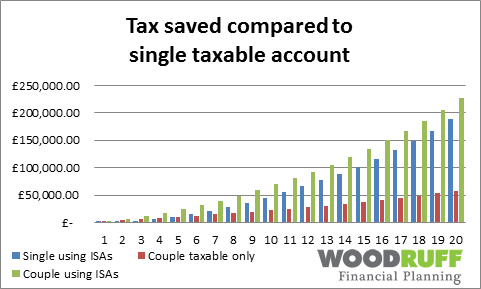
In our scenario, we estimate that Jerry would pay £232,729 in tax over 20 years if he invests in a taxable investment in his name alone.
- Joint taxable accounts (red bar) If the couple sets up a joint taxable account the total tax after 20 years would be £174,936, a saving of £57,793.
- Single taxable account also using ISAs (blue bar) By using Jerry’s ISA allowance, the total tax would be £44,600 after 20 years. This represents a saving of £188,129.
- Joint taxable accounts also using ISAs (green bar) If the couple sets up a joint taxable investment account, and uses both ISA allowances, the total tax would have been £6,293 after 20 years, a saving of £226,436.
What should you do next?
Ask yourself these questions:
- Do you fully use your ISA allowance each tax year?
If not, and you have savings or investments in taxable accounts, you are paying tax unnecessarily. We work with clients to maximise their ISA allowance each tax year. - Do you use your ISA allowance as early as possible?
Most people put off using their ISA allowance until the end of the tax year. Doing this means you pay additional tax unnecessarily. We help clients to use their ISA allowance as soon as the new tax year starts. - Does your spouse use their ISA allowance?
In many couples, one partner may use their ISA allowance, but not the other. If you do not use both ISA allowances you halve the amount of tax you can save.
If you want to examine how much tax you can save by using your ISA allowances, just contact us.
Assumptions used
In our calculations we used the following assumptions:
- Capital growth rate 4%
- Dividend rate 1.5%
- Interest rate 1.5%
- ISA allowance growth 3% per year
- CGT allowance growth rate 3% per year
- All taxable investment annual sales to fund ISAs fall within the annual allowance for capital gains tax
- No capital gains tax allowances used at other times
- Capital gains tax paid at 20%
- No other taxable savings or investments are made
These calculations are made for general comparisons only, and should not be relied on for tax advice or financial advice. Each situation is different, and you should seek professional advice before making any changes to your investments.
Secure your future and live your dreams with Prosper.
An introduction to Financial Planning and Wealth Management
See how we help people in your situation Prosper...
The Personal Finance Portal
Get your free guide to
Our Investment Philosophy
Our investment philosophy document gives you an insight into our investment research process. Fill out the form to download your guide instantly.

Got a Question? Call 01206 919101
PRUDENT SAVER?
Find out how we can help you to Prosper from your savings.
APPROACHING RETIREMENT?
Find out how we can help you to Prosper during retirement.
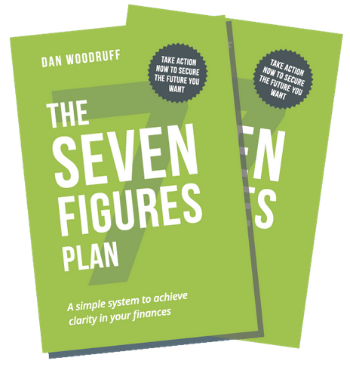
Do you require a simple system to achieve clarity in your finances?
Focus on the 7 most important figures necessary to create your own basic financial plan.
Discover a straightforward way to eliminate the clutter in your financial life to gain clarity on what is actually important with your money.

About Dan Woodruff
Certified Financial Planner & Chartered Wealth Manager at Woodruff Financial Planning
Financial Planning helps you to navigate and anticipate significant life changes. I want to help you to ensure your money is managed wisely to give you the financial security that will fund the future and lifestyle that is important to you.


